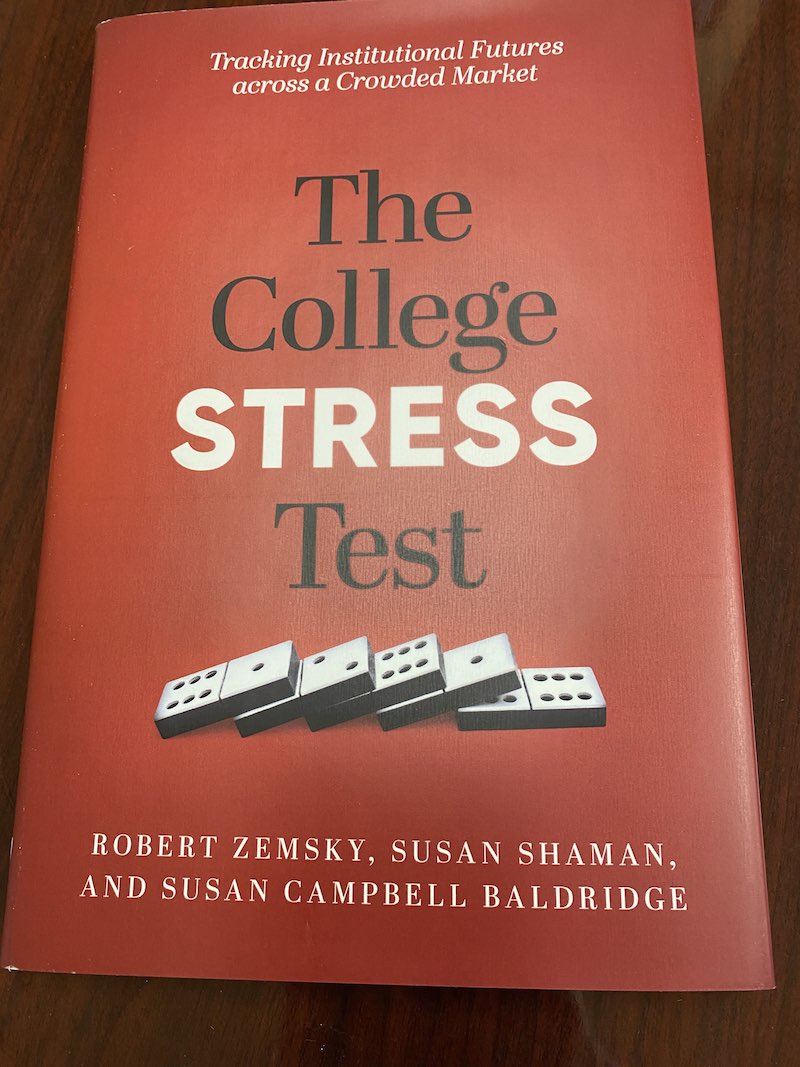My first review of one of Bob Zemsky’s books was in 2008 with Remaking of the American University: Market Smart and Mission Centered, that he co-authored with Greg Wegman and Bill Massy. While Zemsky has written more books post-2008, he’s continued to write about change in higher education and the higher education market. His latest, The College Stress Test, is co-authored with Susan Shaman and Susan Campbell Baldridge, and draws and employs data from the Department of Education’s Integrated Post-Secondary Education Data System (IPEDS) to build a stress test examining the economic viability of 2,800 American colleges and universities.
Zemsky has challenged the prognostications by Clayton Christensen and others that half of these institutions will shut down or merge in the next decade due to technology advances in education. The stress test he and his colleagues developed indicates that just 10% of institutions face substantial market risk and that another 30% will struggle until they find a way to reduce student costs and are willing to change curriculum and experiment with new modes of instruction.
The authors set the stage by bifurcating the higher ed market and noting that the most traditional market for higher education, traditional students pursuing a baccalaureate degree, has grown by approximately one percent annually over the past eight years. They report that the growth in that traditional baccalaureate segment has not benefited all institutions as most of it has been absorbed by a small number of elite schools. Many institutions serving traditional four-year students suffered enrollment declines of 10% or more, with the smallest impacted greatly. In fact, while the market expanded, 65% of two-year publics and 47% of four-year, private non-profits shrunk, and approximately 35% of four-year publics were smaller in 2016 than in 2008.
The authors group institutions into five categories that they presented as a taxonomy in an earlier book, The Market Imperative. The segments — Medallion, Name Brand, Good Buy, Good Opportunity and Convenience — are generally organized from highest to lowest cost. Ironically, from 2008-2016, the schools charging the least lost the most students. That said, size mattered almost as much as segment with smaller institutions losing the most. Region also mattered, with Western institutions experiencing enrollment growth and 25% of those east of the Rockies seeing declines of 10% or more.
After reporting that the enrollment variance was not in the major market category but in certain segments, the authors propose the following select group of variables to be considered in constructing a market stress test score:
- Each variable is derived from IPEDS data collected over the previous eight years (generally, 2008-2016).
- For the four-year, private non-profit sector, health is gauged by two variables: the annual enrollment of first-year, degree-seeking undergraduates and the annual percentage of first-year students returning for a second.
- For first-year enrollment, a trend line is plotted for the eight years of actual data and the slope of the line is used to extend the line another three years forward. These future year points are compared to alert and warning thresholds.
- The percentage of freshmen returning for a second year is charted over the same time period and the slope of that line is also used to trend another three years.
Two financial variables are also used:
- Market price is the average tuition and fees the institution receives after applying the average discount from institutional financial aid (similar to net price used by other higher ed researchers). The change in market price over the eight-year period is charted and a declining average market price reflects an institution’s difficulty in recruiting a new class at the same net price as the prior year(s).
- The other financial measure is a ratio of endowment balance to total institutional expenses (less hospital expenses if the university owns a hospital), computed by using the change from 2008-2015 in the ratio of the end-of-year endowment value to that year’s total expenses.
The authors tweak these variables for the four- and two-year public sectors. They also provide tables for how scores are assigned for rating risks. As the book progressed, I expected to read the overall ratings for the institutions analyzed. However, due to a lawsuit threatened to a company that in 2019 created a scoring methodology for colleges going out of business, the authors opted not to publish a table with all of the scores but instead to publish an appendix that steps a reader through the model to calculate the risk score for their institution. It’s only a matter of time before someone with access to IPEDS follows the cookbook and publishes the scores. After all, the methodology developed here is a college stress indicator, not a predictor of how many more years it will be before the institution runs out of cash.
Zemsky, Shaman, and Baldridge present a methodology for rating institutional stress that uses annual, publicly-disclosed data. Unlike the authors, however, I am less optimistic that these data show a far lower impact to institutions than the percentages forecast by Christensen and others. Having spent many years as a CFO, these alerts may work for public institutions because of the general stability of state support, but are likely too late for small, private, four-year institutions struggling to fill enrollments at the projected market price.
Few institutions can count on funding from alumnae as Sweet Briar College did when its announced closure was forestalled by contributions from alumnae. I believe that the methodology works in this case because the overall market is stable even though a number of institutions are experiencing an inability to attract increasing enrollments at a stable or increasing net price. Based on continuing advances in education technology, including Artificial Intelligence, I believe that the disruption predicted by Christensen and others will happen over the next decade and the Medallions, Name Brands, and large publics will survive but there will be continued disruption and loss of enrollments in the Good Buy, Good Opportunity, and Convenience market segments.
Note: Robert Zemsky was my doctoral dissertation chair at the University of Pennsylvania’s Graduate School of Education. His insights into the market dynamics of higher education inspired us and challenged us as I am sure his current doctoral students are inspired and challenged.











